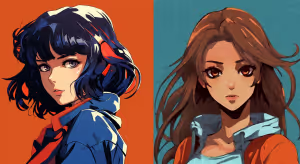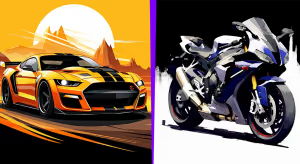There are different types of art. These are differentiated based on specific inherent properties of the art style. Sometimes, these distinctions are not hardlines but help split the art types into two categories for better understanding.
The most common of these distinctions is the difference between 2D and 3D. Many people also do not understand that there are specific sub-differences in 2D and 3D, i.e., there are different sub-types.
Now, we will look at two of them, vector vs. raster art, and also explore the difference between raster art and vector art.
But before that, let us have a comprehensive look at 2D art.
2D art is a type of art that has two dimensions: length and breadth. This is contrasted with 3D art, which has depth as an additional dimension.
2D art was the initial art style that was used. It was famous in a bygone era of animation when classic cel-shaded animation was more common. The art style was later adopted by the gaming industry as well.

Later, the art style became popular in games as well. A lot of game development studios found that it was easier to render than 3D in real-time and had a unique aesthetic. It also quickly evolved in style, starting from pixel art to more elaborate art styles.
Even the advent of 3D, as gaming hardware became more powerful and workstations became better, did not stop the popularity of 2D. There are a lot of games and movies that still use 2D because of its aesthetic.
The major difference between vector art and raster art is that vector art is built from mathematical equations. These art have properties such as position, direction, etc., described in the file.
These are comprised of something called anchor points. These points designate the beginning and the ending points of different lines that comprise the particular vector art.
The biggest advantage of being based on mathematical equations and anchor points is that this type of 2D art can be scaled up. This remains one of the critical differences between vector art and raster art.
For instance, imagine a logo of a company. The logos of companies are standardized assets that represent the brand. Hence, the logo must remain the same across a company’s promotional materials. No changes would be tolerated.
So, if you are a game art outsourcing studio, how do you maintain the same logo proportions across materials of different sizes, ranging from small posters to giant billboards?
Vector art is the answer in these cases. Because vector art would be free to be scaled to whatever size required, small or huge. The artwork would remain the same.
However, there are some drawbacks to vector art. The chief one is that getting higher levels of detail is harder. Because of its inherent property of being based on lines and points, artists would find it harder to implement a higher level of detail.
Second, aspects such as gradients and shadows would also be more challenging. It would require the artists to use specific techniques that would even cease to make it a vector in the first place.
The main difference between vector art and raster art is that raster art is made out of pixels. Pixels are colored dots that, when combined, form an image. For instance, you can see pixels if you take most games out there and zoom in pretty close.
PPI determines the quality of images created using pixels. This stands for pixels per inch, and the higher the number per a given area, the higher the image quality.
Raster art allows artists to create images that have complex colors and details. Things like shadows and gradients are much easier on raster art than on vector art.
However, the main drawback is that raster art cannot be scaled up to any size required without loss in quality. The more you scale up. The more loss of quality you are bound to experience.
Some types of art are more suited for certain things, and others are more apt for others. This is important for the argument of raster vs. vector art.
In the case of vectors, these are perfect for materials that need to be scaled up, such as logos, signage, etc. As said before, these can be scaled up to any size without loss in quality.
It is also suited for certain things like illustrated videos. In addition, it is used for print materials as well.
Generally, if your art does not need specific details and nuance, it might be an excellent option to use for vector.
Conversely, raster is typical for digital photos, illustrations, game art, etc. Because some of these often require subtle nuances and a complex blend of multiple colors. Rasters would be easier to capture these details with than vectors.
So, if you are analyzing the option between vector vs. raster art in terms of suitability, the final line is this: if your 2D art requirements are complex and do not require scaling up the image, you can go for raster.
In terms of file types, there are some differences.
Before we understand the difference, let us briefly tell you the importance of file formats. Not all file formats are compatible across platforms and software. If you create the art in a particular form and then import it to an unsupported platform, proceeding to the next required steps would be more challenging. It may even lead you to restart the whole process from scratch.
Some formats are standard across both vector and raster art. EPS and PDF are two of them. These two are universal formats that are supported by a lot of platforms and software.
Other formats like JPG, GIF, PNG, TIF, BMP, and PSD are typically raster files. Vector files are CDR, AI, and SVG formats.
The software used to create vector and raster files also has massive differences and is a major factor in determining vector art vs raster art.
Getting the right software is also of paramount importance. The right software can create the output the artists wants. The right software does not mean the most advanced or the best in the market. It just means the one most apt to create the output the artist wants.

Illustrator from Adobe is an illustration creation and graphics editor software. It is one of the most popular design software worldwide and is used across industries.
The program’s popularity is primarily because of its comprehensive toolset. It supports the creation of high-quality vectors that can be used for a wide range of media.
CorelDraw is another top vector creation software. It is a versatile tool that provides artists with unique features necessary to create quality output.
The toolset within CorelDraw is extensive, offering you a wide range of options to choose from. It also has a user interface that is intuitive and easy to use.
Inkscape is a professional vector editing software. It is also an open-source software, meaning the code is visible to the entire world for audit.
It is also free to use. The feature set is also good as it is maintained by a community that is invested in improving the tool with each new version.
Now, let us have a closer look at raster creation software:
GIMP is an open-source software used for graphics creation and image editing. It is one of the oldest on the list, first released in 1998.
GIMP has a lot of tools that let artists create stunning raster graphics with minimal time. It is also free software and hence preferred by a lot of artists.
Photoshop is the most famous on this list. It is an image editing and raster editor software developed by Adobe.
It has one of the most significant tool set ranges across all software, allowing artists to develop complex images with hyper-specific details.
There are numerous differences between vector art and raster art. But each of them has their unique strengths. Raster is suitable for detailed illustrations and images. Vector is unique for logos and materials that need scaling up.
But both come with their drawbacks as well.
However, choosing one over the other would be based on the requirements of your project. Because there is no final verdict of one being better than the other.
We at Juego Studios are a top video game development company that has a team of experienced game artists ready to tackle projects of any scope. Our team has experience in multiple game genres and art styles and creates the quality output you want using the latest visual editing software.
1. What is the difference between vector art and raster art?
Vector art is made up of mathematical equations and lines. Raster art is made up of pixels.
2. What are some software used to create vector art?
Adobe Illustrator, CorelDraw, and Inkscape are software used to create vector art.
3. What are some software used to create raster art?
Adobe Photoshop and GIMP are two top software used to create raster art.